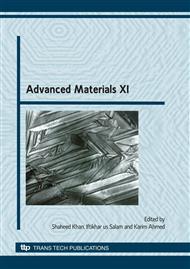p.221
p.227
p.236
p.242
p.250
p.255
p.263
p.268
p.275
Effect of Thermal Treatment on Coercivity of SmCo5 Sintered Magnets
Abstract:
Permanent magnet materials composed of transition and rare earth metals exhibit high energy products. Samarium cobalt magnets are developed and research is done to have high coercivity. Chemistry is varied from 34 to 36 weight percent of samarium in Sm1Co5 compound. Effect of chemistry and sintering treatment temperatures on final properties has been studied. Magnets are manufactured by powder metallurgical technique involving isostatic pressing and sintering in inert atmosphere at temperatures range of 1140-1170°C. Then the magnets are subject to post sintering aging treatment in temperature range of 800-900°C. It is observed that coercivity of Sm1Co5 magnet varies with aging temperature and can be improved by post sintering aging treatment.
Info:
Periodical:
Pages:
250-254
Citation:
Online since:
June 2010
Authors:
Keywords:
Price:
Сopyright:
© 2010 Trans Tech Publications Ltd. All Rights Reserved
Share:
Citation:


